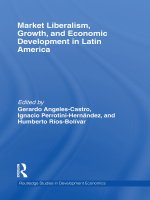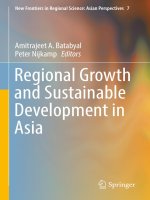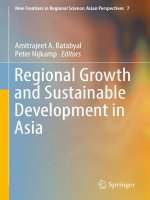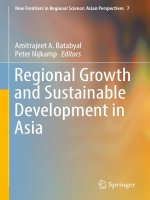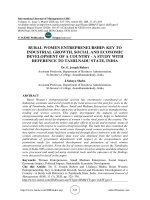Economic growth and economic development 92
Bạn đang xem bản rút gọn của tài liệu. Xem và tải ngay bản đầy đủ của tài liệu tại đây (84.47 KB, 1 trang )
Introduction to Modern Economic Growth
the fundamental law of motion of the capital stock becomes
k˙ (t)
= sA − δ − n.
k (t)
Therefore, if the parameters of the economy satisfy the inequality sA − δ − n > 0,
there will be sustained growth in the capital-labor ratio. From (2.38), this implies
that there will be sustained growth in output per capita as well. This immediately
establishes the following proposition:
Proposition 2.10. Consider the Solow growth model with the production function (2.38) and suppose that sA − δ − n > 0. Then in equilibrium, there is sustained
growth of output per capita at the rate sA − δ − n. In particular, starting with a
capital-labor ratio k (0) > 0, the economy has
k (t) = exp ((sA − δ − n) t) k (0)
and
y (t) = exp ((sA − δ − n) t) Ak (0) .
This proposition not only establishes the possibility of endogenous growth, but
also shows that in this simplest form, there are no transitional dynamics. The
economy always grows at a constant rate sA − δ − n, irrespective of what level of
capital-labor ratio it starts from. Figure 2.10 shows this equilibrium diagrammatically.
Does the AK model provide an appealing approach to explain sustained growth?
While its simplicity is a plus, the model has a number of unattractive features. First,
it is a somewhat knife-edge case, which does not satisfy Assumptions 1 and 2; in
particular, it requires the production function to be ultimately linear in the capital
stock. Second and relatedly, this feature implies that as time goes by the share
of national income accruing to capital will increase towards 1. We will see in the
next section that this does not seem to be borne out by the data. Finally and most
importantly, we will see in the rest of the book that technological progress seems to
be a major (perhaps the most major) factor in understanding the process of economic
growth. A model of sustained growth without technological progress fails to capture
this essential aspect of economic growth. Motivated by these considerations, we next
78
